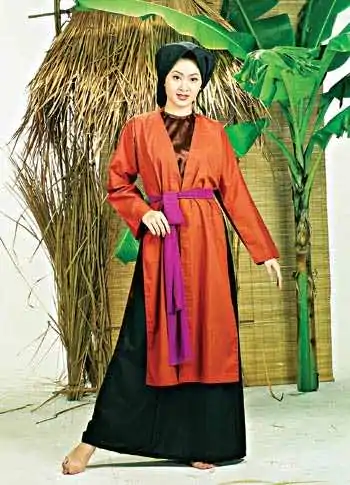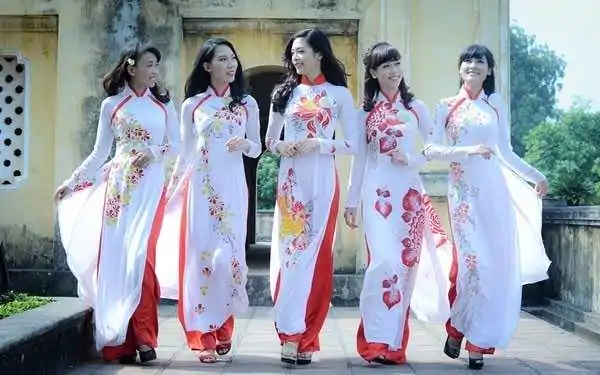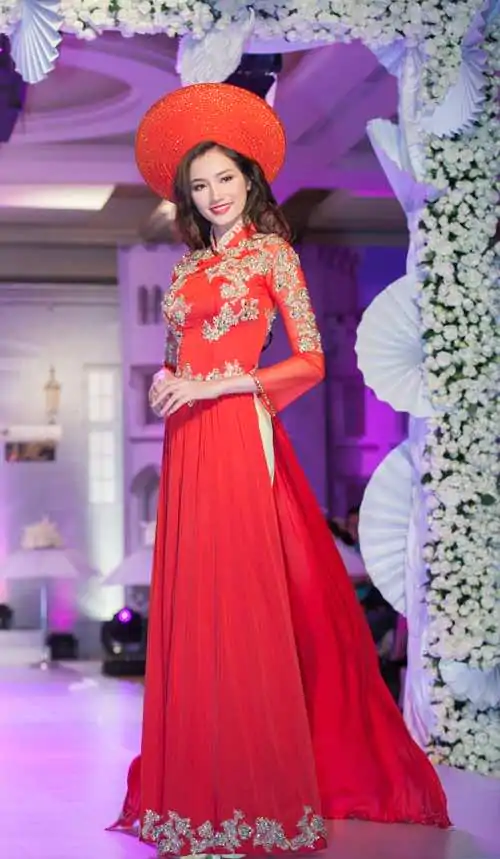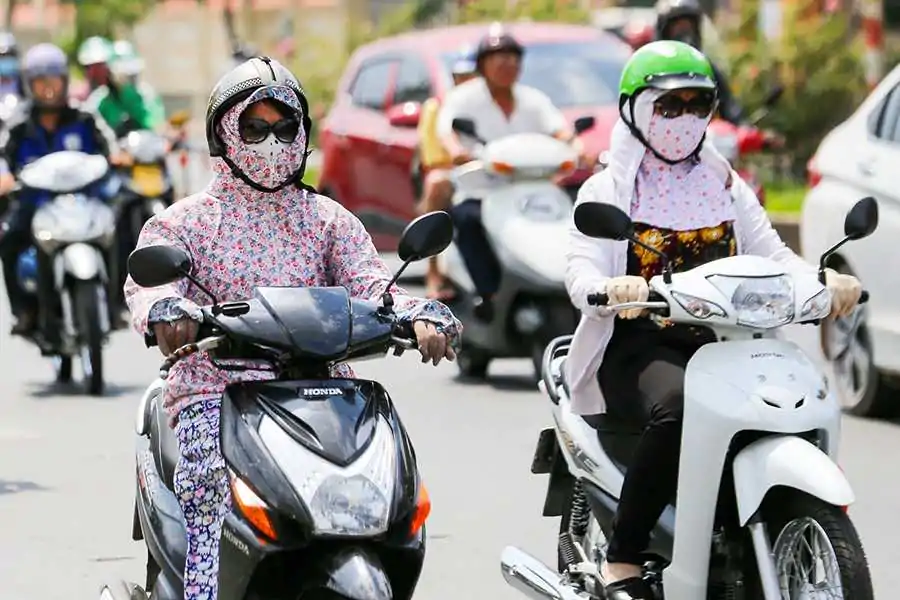‘Ao dai’ is a familiar name with Vietnamese people as well as the international community. This is the traditional costumes of Vietnam and a charming symbol of Vietnamese women. In the modern world, you can catch sight of ‘ao dai’ at almost every places in Vietnam: the uniform of high school girls, the uniform of women teachers, the formal costume of office girls, receptionists, air stewardesses and also somewhere on the street.
‘Ao dai’ seems to be a longstanding culture of Vietnam and really rich in its development history. This article will bring you back to the date ‘ao dai’ was gradually created and then becomes the national symbol of Vietnam.
The origin of ‘ao dai’
In fact, no one thoroughly knows when the original version of ‘ao dai’ was born and how it looked like as there is no historic record of this. According to the inscriptions on Ngọc Lũ copper drum which was created thousands of years ago, the most ancient clothes of Vietnamese was a long dress with two different flaps. ‘During the Northern colonial period, the dress of Vietnamese was buttoned up to the left, later when the Chinese culture was introduced, it was buttoned up the right.

The most ancient type of ‘ao dai’ recorded was called Giao Lãnh (about the 17th century). This is the original version of ‘áo tứ thân’. But the front long flaps are not tied together but dropped freely or left intersected. The clothes are further dressed with a type of camisole, a long black dress and a colored fabric belt used to tie up around the waist.

However, later due to the work of farming or trading, Giao Lanh ‘ao dai’ was reduced into ‘áo tứ thân’ (which means a 4-long-flap dress). This dress includes: the right half of front flap, the left half of the front flap, the right half of behind flap, the left half of the behind flap). ‘Ao tu than’ was dressed out of the original black dress so that the whole set is convenient to carry items on their shoulders. Still this dress could also remain the charming beauty of the working women. As the costume for working class, ‘ao tu than’ was usually made from dark fabric to avoid getting dirty. On the other hand, urban women who are usually not working chose to dress in ‘áo ngũ thân’ (which means a 5-long-flap dress). This dress was majorly the same as ‘ao tu than’ except an additional flap was sewn under the two front flaps. These two dresses are also the distinction feature between women in the rich families with those from the working class. This collared dress was still very popular until the 20th century.

The development of ‘ao dai’
1. Nguyễn Phúc Khoát
Nguyễn Phúc Khoát – Vũ Vương (a title equal to King) laid the foundation for the shape of ‘ao dai’. Until the 16th century, the clothes of Vietnamese people were still influenced by the costumes of Chinese. With a view to creating a distinguished feature for the nation, he proclaimed an order in which he mentioned how Vietnamese dressed. Accordingly, he described the national form of ‘ao dai’ which was rather similar to the modern one.
2. Le Mur
Le Mur is the French name that artist Cát Tường used to call the ‘ao dai’ she created. However, in that time, this ‘ao dai’ was too sophisticated and innovative that many critics blamed it as ‘exotic’ and refused to wear it widely.

3. Lê Phổ
Le Mur ‘Ao dai’ was born in 1930. Up to 1934, artist Lê Phổ decided to create a different version of ‘ao dai’ by combining the modern characteristics of Le Mur with the traditional features of ‘ao dai’ from the ancient times. This combination received a widespread support of the general public. Since then, ‘ao dai’ had a distinguished shape of its own. Despite many ups and downs so far, Vietnamese ‘ao dai’ always has the basic form of Lê Phổ’s design.
4. Giác lăng ‘ao dai’
To further facilitate the tailoring and styling of ‘ao dai’, ‘áo dài giác lăng’ was born. Basically, this type of ‘ao dai’ still maintained the form of Lê Phổ, however, its sleeves were separated and later tailored to the main body. This ‘ao dai’ has a line of button on the shoulder and spread down to the waist. This design helped to reduce the wrinkles on the sleeves. Furthermore, ‘ao dai’ was tailor as slim design that was closer to the body.
5. ‘Ao dai’ with boat neck
Boat neck, or bateau neck or Sabrina neckline, was combined with ‘ao dai’ by Mrs. Trần Lệ Xuân. This design was ranked to be one of the most seductive designs of ‘ao dai’. Unlike the traditional discreet design with tall collars, ‘ao dai’ with boat neck is more charming with deep carved neckline and elegant patterns on the fabric. Mrs. Trần Lệ Xuân passes away at 2 a.m on April 24th 2011 in Rome, Italia, aging 87 years old at the time.

‘Ao dai’ in the modern lifestyle
These days, along with the fast-paced development of the society, ‘ao dai’ also has its own path to develop. ‘Ao dai’ becomes more diversifying in its designs although it still remains the past original form. There are a wide range of materials to tailor ‘ao dai’, however, silk is always the most favorable choice. In fact, ‘ao dai’ has been by no means strange to foreigners as you can always catch sight of this charming dress in the international beauty contests. Additionally, based on their special ardor for ‘ao dai’, many western women decide to have their own Vietnamese ‘ao dai’. Even more interesting, although the western marriage custom with white soiree and gown has long been popular in Vietnam, recently many brides chose to go back to the ‘ao dai’ as their wedding dress. This made them even more charming in the combined design of modern and traditional features.



 Tuan
Tuan April 25, 2019
April 25, 2019 Travel Guide
Travel Guide
 3997
3997 YOU MAY ALSO LIKE
YOU MAY ALSO LIKE
 read more
read more
